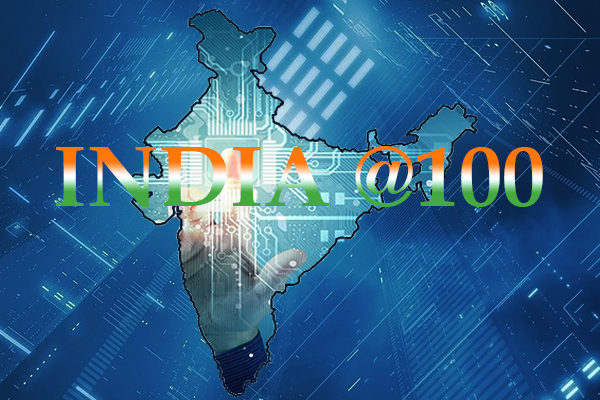In a media interaction on the first day of the New Year, Union Minister of State (Independent Charge) Science & Technology Dr Jitendra Singh said, “2023 Science Vision will define India at 2047”. The year 2023 happens to be the first of the last 25 years before independent India turns 100 in 2047 and realizes its India@100 dreams.
Finance Minister Nirmala Sitharaman presented the Union Budget 2023-24 on 1st February. She termed the budget as the first budget of the Amrit Kaal. FM said, “Vision for the Amrit Kaal includes a technology-driven and knowledge-based economy.” Certainly, technology has got the centre stage in the vision for Amrit Kaal. Moreover, of the seven priorities set in the budget, Green Growth has been in 5th place. This is significant for green technology development and for India@100.

Departments dealing with Science and Technology have already outlined their focus and thrust areas for the year 2023.
ISRO has its focus on scientific exploration missions, Technology Demonstration missions and the Human spaceflight program “Gaganyan” in 2024. It has recently opened Space Sector to private participants.
The department of Biotechnology (DBT) would take forward the successes of the COVID-19 vaccine mission. It will be investing in the improvement of vaccines for existing and emerging diseases.
CSIR will also focus on Green Hydrogen. It has already made headway in Green Hydrogen indigenous as part of the clean energy mission.

The Ministry of Earth Sciences (MoES) will focus on the Deep-Sea mission & technologies. It will add value to India’s economy in the years to come. The year 2023 will also witness further headway in Blue Economy.
Announcements in 2023 Science Vision has been welcomed by the industry, Sameer Gandhi, MD, OMRON Automation, India says, “OMRON applauds the announcement of Science Vision. We believe it is a great initiative to pave way for bringing in more innovation and R&D temperament in the technology sector.”
Recent Progress:
In recent years, India has emerged as a significant player in the global science and technology scene. Smartphone shipments from India crossed the Rs 50,000-crore mark during April-November 2022. It is up 110% compared to the same period last year. Further, to deepen domestic value addition in the manufacturing of mobile phones, the FM in union budget 2023-24 has announced to provide relief in customs duty on the import of certain parts and inputs like camera lens and continue the concessional duty on lithium-ion cells for batteries for another year.

Further, Vedanta and Foxconn announced an investment of $19.5 billion (1.54 trillion rupees). They set up a semiconductor plant in Gujarat. PM Modi launched 5G services in India on 1 October 2022, at the India Mobile Congress. With the launch of the 5G services, there will be further expansion in the IoT and 5G use cases. It will give further impetus to the development of the electronics sector in India. The automotive sector brought forward the advancement of ADAS technology in India.
To further promote the 5G services in India, the union budget 2023-24 has decided to set up one hundred labs for developing applications using 5G services. Further, the labs will be set up in engineering institutions. It will help in realizing a new range of opportunities, business models, and employment potential.
Further, these 25 years, before independent India turns 100 in 2047 and realizes its India@100 dreams, are crucial for India to emerge as a leader in Science and Technology. Policy, support, initiatives, and investments from both the public and private sectors will decide India’s position globally in 2047.

New Technologies:
Historically, innovation and investment in emerging areas and technologies are decisive factors in who will lead the world. For India to realize its India@100 dreams it has to make investments in the emerging areas of technology. Anurag Awasthi, Vice President of IESA says, “Critical Electronics with embedded security for both commercial as well as Defense and Aerospace applications, Semiconductor manufacturing using green processes with alternate materials, Biomedicine as well as Chemical and Biomolecular applications, AR/VR/MR, Quantum computing for a multi-sector applicability and Space technologies to include management of Space debris are some more areas which have the potential to give India a leading edge in 2047.”

Highlighting the ways India can remain globally competitive moving forward, Sudha KV, VP, Dell Technologies India says, “We need to build a larger community of Technically skilled talent, with innovation as its core value. It will not only help build our path to success in the age of technology but also help us meet the lofty aspirations of the Science Vision. Artificial Intelligence, Machine Learning, Automation, and 5G will benefit people at every level. For India’s public, private, and cooperative sectors to remain globally competitive, they must actively pursue these fields and implement solutions.”
Skill:

Becoming a leader in Science and Technology involves highly qualified scientists and a skilled workforce. Dr Abhilasha Gaur, COO, ESSCI says, “ESSCI is assisting in the continuing process of developing skilled labour; we are preserving ties with industry, academia, subject matter experts, and, most recently, researchers.”
If India wants to realize its India@100 dreams and lead in Science and Technology in 2047 it must counter a few challenges. Research and Development of new technologies involve huge investment, a highly skilled workforce, and infrastructure. Anurag says, “The challenges are to continuously expand the reach of science education with a qualitative and not a quantitative footprint, establishment of a large R&D infrastructure and development of a cutting-edge faculty with a continuous industry interface all across the country.”

India has the largest share of the youth population in the world. This population is very significant in realising India@100 dreams. This young population, if provided with quality education and skill can be a game changer for India. Sudha says, “We need to provide an ecosystem where we bring in under-represented groups, especially more women into the technology workforce and sustain them. Youth is the future of India, and we must invest in educating and upskilling students to encourage an early interest in technology and educate businesses to invest more in future-ready talent pools to support their sector’s growth. Everyone in the industry from the grassroots levels to leadership roles will need to be invested in these endeavors.”
To compete on a global level and accomplish the set objectives for India@100 dreams, rural India needs to be served. Abhilasha says, “We should build the ability to mobilise rural youth and scale them into the required abilities, especially in rural regions, so that they are completely prepared.”














